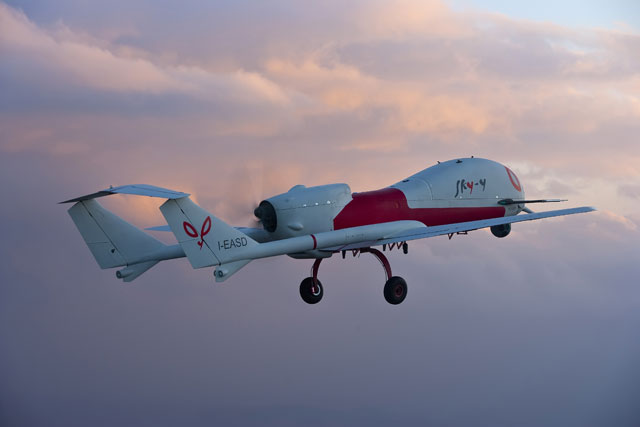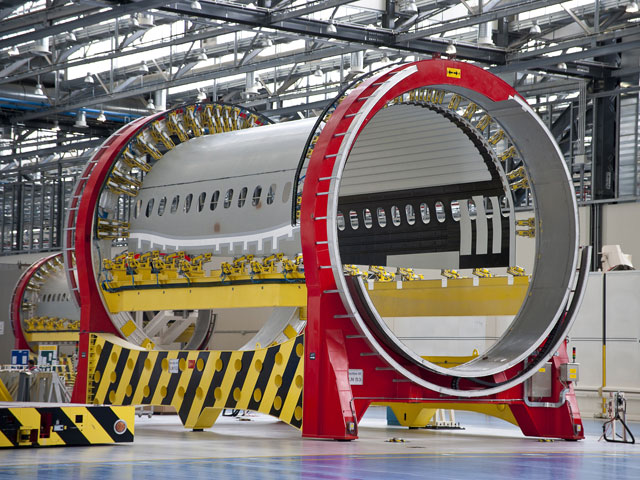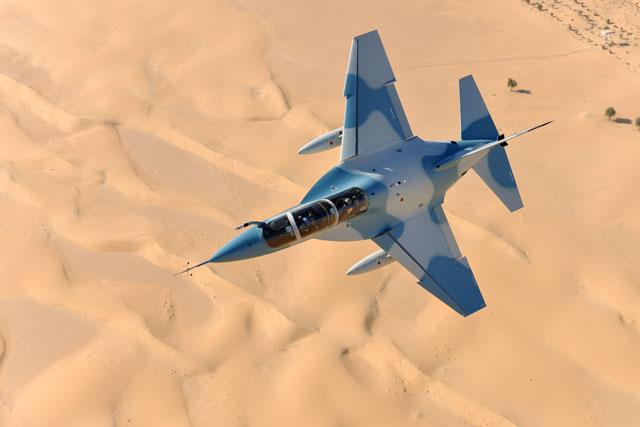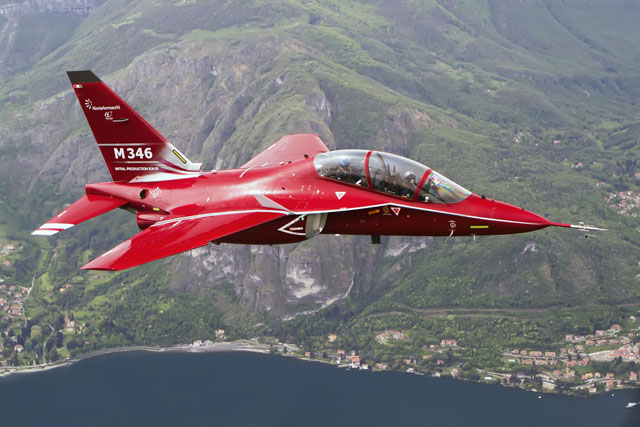Two stalwarts of Italy's century-old aerospace industry were united on 1 January 2012, when the interests of Alenia Aeronautica and Alenia Aermacchi were merged, creating a new entity with almost 12,000 employees.
Now operating under the unified name Alenia Aermacchi, the company produces a range of military trainers - including the M-346 Master - and the C-27J Spartan tactical transport. It also assembles Italy's Eurofighter combat aircraft and prepares special-mission versions of ATR-family regional turboprops.
Further activities include providing upgrades for the Italian air force's Panavia Tornado strike aircraft, developing valuable expertise in the unmanned air systems sector, through flying demonstrators such as the Sky-X and Sky-Y platforms, and having a role in Europe's multinational Neuron programme.
 |
|---|
Alenia Aermacchi Experience in the UAS sector was gained in flying the Sky-Y platform |
In the commercial sector, the company is involved as a supplier on numerous airliner programmes, including manufacturing structures for the Boeing 777 and 787 and Bombardier CSeries aircraft, and working with Sukhoi on the Superjet International joint venture.
The merger process has involved closing one headquarters in Rome - focusing all such activities in Turin - while withdrawing from several small production sites, including in Brindisi and Venice.
"Now we have completely integrated the organisation - not only staff, but also the engineering," says Alessandro Franzoni, co-chief operating officer for technologies and industrial systems. "We are working as one company from all standpoints."
The process has yet to be completed, however, with some further steps required to address any remaining areas of duplication.
"We still have a quite complex footprint in Italy," Franzoni says, pointing to a legacy of the nation's aerospace industry having been established around hubs in Naples, Turin and Venegono from early in the last century.
From a cultural standpoint, the merger has been a fairly straightforward process. "The two companies had a long tradition of working together," Franzoni notes. Long before becoming shareholdings of the Finmeccanica group early in the last decade, this included their collaborating on the development and production of the Italian/Brazilian AMX combat aircraft, and in manufacturing the G222 transport - the basis for today's C-27J.
 |
|---|
Alenia Aermacchi The C-27J retains about 95% of the G222's fuselage structure |
Main activities are being retained at the company's two Turin-Caselle sites, and at Venegono Superiore, near Varese. The former houses final assembly lines for the C-27J and Eurofighter, along with left wing and rear fuselage assembly work for every one of latter type produced, in addition to hosting flight-test activities. Venegono remains the location for military training aircraft production.
Elsewhere in northern Italy's Piedmont region, new infrastructure is also being put in place at the Italian air force's Cameri air base for a final assembly and check-out line for the service's Lockheed Martin F-35 Joint Strike Fighters. Some wing production for the stealthy, fifth-generation type will also be performed at the site.
Already flown by the Italian air force and export customers Bulgaria, Greece, Lithuania, Mexico, Morocco and Romania, the C-27J's prospects appeared to have sky-rocketed when the type was selected for the US Air Force/Army Joint Cargo Aircraft (JCA) programme.
The disappointment of a 2011 decision to halt the JCA procurement after only 21 of an initially approved 38 aircraft prompted the then Alenia Aeronautica to slow its final assembly rate for the twin-engined type. Its Turin South site has the capacity to complete 14 or 15 of the transports per year, but has so far been taken to a maximum rate of nine and is currently running below that level, says Susanna Perfumo, head of C-27J production. It could be sustained at a minimum of six.
A boost came in May when Australia confirmed a 10-aircraft deal, placed via the US government's Foreign Military Sales mechanism, in association with JCA prime contractor L-3 Communications Integrated Systems. The fuselage for its first example is due to arrive in Turin late this month. Another, so-far undisclosed nation has also recently signed up under a direct deal with Alenia Aermacchi, and "several customers have already defined numbers, price and delivery schedules" for additional examples, says Massimo Ghione, vice-general manager, marketing and sales.
The company has also not given up on delivering more aircraft under the JCA programme, citing the C-27J's popularity within the US Army and Air National Guard units which operate the type. This, it believes, could yet see the additionally planned 17 aircraft manufactured.
Despite the addition of US-specific mission equipment by L-3, Alenia Aermacchi says the JCA platform is 95% common with the Spartans flown by launch export buyer Greece, which has eight in air force service.
The company's development strategy for the C-27J differs from that of sector rival Airbus Military, which offers its CN-235 and C-295 products in a variety of special-mission derivatives, most notably for the maritime patrol and anti-submarine warfare roles.
Such requirements are better served by offering modified versions of the commercially popular ATR 42 and ATR 72, the company believes, with the latter now being adapted for use by the Italian air force and Turkish navy. Ghione says the company has submitted proposals in three additional countries and is currently in discussions with them.
"We have a wonderful tactical transport," he says of the Spartan. "If you have an aeroplane doing everything then you are not at the top. We are at the top, and we want to remain there."
One exception is the Italian air force's provision of funds to develop an electronic warfare mission fit for the C-27J, with the so-called JEDI equipment now being trialled in Afghanistan.
Another is the ongoing development of an MC-27J gunship version. A prototype is being prepared for first flight in the armed configuration in 2013, with the project being pursued with ATK. A mock-up of the concept - which adds a palletised weapon and sensor package - was unveiled during July's Farnborough air show, and the companies have since been approached "by a number of countries", Ghione says. The product could eventually fill a market niche for between 20 and 30 such aircraft, he believes.
Other near-term opportunities for special mission deals include a South African requirement for eight aircraft to perform maritime patrol duties and other tasks, and Canada's pending fixed-wing search and rescue contest. A version of the C-27J is being promoted for the latter deal with local partners including Finmeccanica company DRS Canada, plus General Dynamics Canada and Provincial Aerospace. A tender for the requirement is expected soon, with the team likely to offer a solution based on the supply of 15 or 16 aircraft. Competition will come from Airbus Military's C-295, and from Lockheed's larger C-130J.
Alenia Aermacchi also lists India and Saudi Arabia as other potential future Spartan operators, and is continuing discussions with Slovakia, which previously selected the type.
Meanwhile, Afghanistan's new air force is gaining valuable air transport experience with its C-27As, remanufactured from retired Italian air force G222 airframes by Alenia Aermacchi in Turin. Its inventory of the type will eventually total 20 aircraft.
The airframer is now investigating potential ways of enhancing its battlefield airlifter, some 15 years after it entered development and with more than 50 aircraft delivered.
"We are improving the product, to make it a little bit cheaper and to reduce flow times," says Franzoni. Shortening the production process is important, he notes, as many customers cannot wait longer than 24 months to receive new aircraft.
The C-27J retains about 95% of the original fuselage structure for the precursor G222, which was designed in the late 1960s. Manufactured at Alenia Aermacchi's Capodichino facility, near Naples, this is delivered to Turin-Caselle by truck, a distance of about 432nm (800km), before entering final assembly. The process takes between eight and nine months per aircraft, before any mission-equipment installation activities are carried out in the USA by L-3.
Weight reductions are also being sought, Franzoni says, along with a requested 5% increase in power output from the Spartan's two Rolls-Royce AE2100-D2A engines. Each is currently rated to produce a maximum output of 4,650shp (3,470kW), but boosting this would enable operators to increase the type's payload capacity, climb rate or range performance. Additional activities include obsolescence management for some aircraft systems, he adds.
Turin-Caselle is also the location for Italy's Eurofighter final assembly line, along with the assembly of the left wing, which is made including composite upper and lower panels manufactured at Alenia Aermacchi's Foggia plant in southern Italy, and the rear fuselage for every Typhoon produced.
 |
|---|
Alenia Aermacchi Boeing's 787 is among airliner programmes for which Alenia Aermacchi builds structures |
To extend production activities until at least 2017, work has been slowed across the four Eurofighter partner nations, which also include Germany, Spain and the UK. Capacity has been reduced from completing 60 aircraft per year to roughly 40 in 2012, including six or seven for the Italian air force. The act is intended to give more time for the core customers to decide whether to approve a final, Tranche 3B production phase contract for the last 124 of their planned 620 aircraft, or to secure additional export sales.
 |
|---|
Alenia Aermacchi Turin-Caselle is the locaation for Italy's Eurofighter final assembly line |
Italy's last Tranche 2 production example is currently on the line, with work transitioning to the Tranche 3A version. This introduces minor design changes to support the planned installation of an active electronically scanned array radar and conformal fuel tanks.
Alenia Aermacchi's newest assembly facility is up and running at its Venegono Superiore plant, where the mood is optimistic following the M-346 advanced jet trainer programme's strong progress during 2012.
In mid-July, the manufacturer signed a $1 billion, 30-aircraft deal with Israel, before formally rolling out its first example for Singapore early the following month, also confirming that the aircraft had already been flown.
"The delivery of the first M-346 is scheduled for the end of 2012," it said with regard to the latter deal, which covers the provision of 12 aircraft under a programme headed by Singapore Technologies Aerospace.
Italy's air force was the launch customer for the twin-engined type, with two of its locally designated T-346As having been involved in evaluation activities by service pilots at Lecce air base since last year. Certification activities are also being performed for the service, with several enhancements also to be incorporated. "They have identified some man-machine interface changes for the baseline configuration," Franzoni confirms.
 |
|---|
Alenia Aermacchi A $1 billion 30-aircraft M-346 deal was won in July |
Elsewhere, a vital remaining element of the M-346's flight performance is soon to be demonstrated, with high angle of attack trials with a spin-chute recovery system installed to be performed. The work was to have been conducted using a development aircraft, which crashed after departing the Dubai air show in November 2011. The company and local accident investigators have not detailed the full cause of the mishap, but Alenia Aermacchi says it has been linked to an issue and configuration unique to that particular prototype.
Announced following a competition with the Korea Aerospace Industries (KAI)/Lockheed Martin T-50, the M-346's win in Israel included an added bonus. To be acquired by a TOR Systems joint venture between Elbit Systems and Israel Aerospace Industries, and made available for use by the nation's air force, the aircraft had initially been expected to undergo some local assembly work. The final agreement is that all 30 aircraft will be completed in Venegono Superiore, with the manufacturer also to provide long-term technical support. Another condition of the deal is that Elbit will not be able to offer future upgrades of the M-346 to other customers.
"We are responsible for the whole aircraft - we are delivering a product, not just a kit," Ghione says. He also believes Israel may eventually look to increase its purchase by another five or 10 aircraft, with the type to be used to prepare Israeli pilots to convert on to the conventional take-off and landing F-35A.
"Our orders are growing significantly," Ghione says, noting that the United Arab Emirates is still interested in the M-346, despite not yet advancing a planned 48-aircraft selection announced in 2009.
But without question, the main target for the Italian aircraft is the US Air Force's potentially 350-unit requirement to replace its Northrop T-38 Talon trainers. Alenia Aermacchi, and several rivals, are waiting for the service to release a full request for proposals, with a draft document having been published in October.
Plans to offer a T-100 integrated training system comprising a US-optimised development of the M-346 and related simulators, other ground-based training infrastructure and courseware for the T-X programme have previously been announced. But with the prospect of a contest drawing nearer, Alenia Aermacchi is within weeks of announcing a new strategy for the campaign.
 |
|---|
Alenia Aermacchi The M-346 advanced jet trainer programme has progressed strongly |
The company had previously suggested its bid would be led by its Alenia North America unit, but it now intends to join forces with a local partner to serve as prime contractor.
"Quite soon we will advance our teaming agreement with a US company - we cannot compete alone," Ghione says, confirming it has looked at several potential partners. "Our strategy has already been fixed. The question is who will be responsible as prime."
The T-X opportunity will be hard fought, with other bidders to include BAE Systems/Northrop Grumman, offering the Hawk; Lockheed Martin and KAI with the T-50; and Boeing, which is understood to be developing a new design. "If the requirement is to stay off the shelf or almost off the shelf we are very well positioned," Franzoni argues, adding: "We have the best product and system."
While the company is waiting on the USAF, it is also looking to offer the type to the Philippines, although the nation's air force is reported to be interested in KAI's armed F/A-50. It also is waiting on the requirements of Poland, and other nations involved with the slow-moving Advanced European Jet Pilot Training initiative.
Lower down its trainer product line is the proposed M-345; a rebranded version of the M-311 jet. Studies have been performed looking at new engine and avionics options, and Alenia Aermacchi says it could launch the programme if it secures sufficient backing. The Italian air force is viewed as a potential launch customer, as it needs to replace some of its oldest MB-339s, and Ghione says it will also consider a partnership "with other countries which want to grow in aerospace".
A further deal for the MB-339 could be secured with the UAE, meanwhile, which could seek to acquire a further two airframes for its recently formed Al Fursan - "The Knights" - aerobatic display team, which was trained in Italy by the air force's Frecce Tricolori and has seven aircraft.
Additional sales for the SF-260 primary trainer could also be secured, with more than 900 of the type having been delivered so far. While sales bring in only modest financial returns, the aircraft is described as important in building relationships with nations which may go on to acquire its higher-end jet trainer products.
Thoughts have already turned to designing a possible successor for the SF-260, with a composite or modular airframe a potential future result. However, an upgraded example with a new glass cockpit has just returned from a demonstration in the Middle East, and Mexico has previously indicated interest in acquiring another 40 of the aircraft.
Similarly, Alenia Aermacchi is looking to work in partnership with other companies or nations to develop a future medium-altitude, long-endurance unmanned air system, as the cost of doing so alone would be prohibitively high.
In the commercial sector, the company is poised to deliver its first empennage for the CSeries regional airliner, and recently transferred its 100th mid-fuselage section for the 787. The first Sukhoi Superjet to be outfitted in Italy was "rolled in" for completion for Interjet in Venice in October, and thought has already been given to what will succeed the current ATR product range, which Franzoni hails as now being in its "second life" following an upturn in sales. The turboprop is the result of a joint venture with EADS.
Now merged and with interests across a broad range of platforms and capabilities, the new Alenia Aermacchi looks to be well placed to deliver for its parent company in the coming years.
Source: Flight International



















